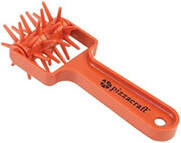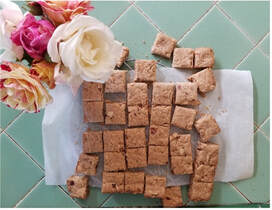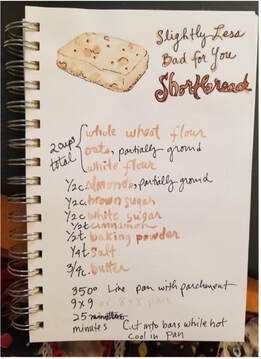Here at My Tea Planner, we have a special love for shortbread. While many cookies go wonderfully with a hot cup of tea, buttery, crumbly, just sweet enough shortbread makes a perfect companion. Traditional shortbread appears at nearly every tea party that I give, year-round and certainly is anticipated on all holidays. As shortbread freezes extremely well, there is usually a tin of shortbread hidden in the back of my freezer. Recipes for no less than eight flavors of shortbread can be found at My Tea Planner. We have recipes for shortbread versions featuring poppy seed, Kona coffee, rosewater, lavender, black sesame, chocolate, and the recipe rumored to be Queen Elizabeth’s favorite shortbread. In my 2018 holiday blog, I gave a large batch shortbread recipe that makes a solid sheet pan’s worth of squares or bars. Find that recipe here: Sheet Pan Scottish Shortbread Recipe.
Though shortbread is found throughout the tea-drinking British Commonwealth, it is associated most closely with Scotland. In my research on shortbread, I found a real gem of a website called Historic UK which has both intriguing articles on many British topics and a searchable database of historic accommodations including castles, bed and breakfasts, county hotels and canal boats. Their article, “The History of Scottish Shortbread,” gives a good recipe and lays a pretty good argument for Mary, Queen of Scots, bringing a shortbread-like cookie from the French court. It is a quick, fun read, here: The History of Scottish shortbread . For the anglophiles among us, we’ll want to bookmark their website and take a fantasy trip through British lore and castles while having our tea and shortbread break.
As much as I love plain shortbread, I am a baker who can’t leave well enough alone. The traditional shortbread ratio is roughly one part sugar, two parts butter, to three parts flour. The texture of shortbread is what sets it apart from a blondie, a butter cookie, or vanilla wafer. Shortbread’s dominant taste should be butter, so here is the time to use the freshest, highest quality butter you can find. This is a good use of the European-style high fat butters. Shortbread is also much less sweet than most cookies. Shortbread recipes do not contain eggs or any leavening. The little holes seen on the surface of shortbread help to keep it from puffing, much like you’d prick a blind-baked pie crust. Pricking with a fork every half inch or so looks pretty and will help the texture. If you happen to have a fancy spiky wheel called a dough docker, it can be used instead of a fork.
When Louise and I were in Scotland, we were served a creamy, local bleu cheese on wholemeal oat biscuits. They were thicker and sweeter than American crackers, almost like an American cookie. The combination was just heavenly. I searched around for recipes to replicate them and found a Martha Steward recipe that called for ground oats and almonds and a tiny hint of cinnamon. While not precisely like the British ones, they were very tasty and similar in texture. The downside to these was they were fussy to shape into rounds and they called for a ton of butter.
I decided to morph these cookies into bars that had a sandy, crumbly texture similar to shortbread. The flavor of almonds and toasted oatmeal, with that slight warming hint of cinnamon, was a hit. Over the course of a few months, I baked batches of them for different occasions and always got rave reviews and requests for the recipe. I love that oats and shortbread, two most Scottish ingredients, have found each other and have been so in love.
This was my first working recipe, above. The final recipe, below, has less butter and less sugar than the former. Both recipes work as written. There was also an intermediate version with all brown sugar that was deliciously caramel-y but it softened the texture too much for my liking. This recipe can be doubled very successfully and baked in a 13” by 9” baking pan. Vanilla is not a usual ingredient in shortbread, but I do thinks it adds a little extra something. Feel free to leave it out.
Makes 3 dozen 1” squaresSpecial equipment: baking sheet, metal spatula, medium mixing bowl, food processor or blender or coffee grinder, hand or stand mixer, silicone scraper, 8” or 9” metal square pan, lined with parchment paper, knife or bench scraper, cooling rack
Preheat oven to 350 degrees F
- 1 cup old fashioned oats
- ½ cup sliced almonds
- ½ cup (1 stick) butter, softened
- 2 tablespoons oil such as canola, walnut, or coconut, optional
- 1/3 cup granulated sugar plus a bit extra for sprinkling, if desired
- 1/3 cup brown sugar
- ½ teaspoon vanilla, optional
- 1 cup all-purpose or whole wheat flour or a blend of the two
- ½ teaspoon ground cinnamon, use ¼ teaspoon if using high-quality cinnamon
- ½ teaspoon baking powder
- ¼ teaspoon salt
- Toast oats and almonds: spread oats on two-thirds of a sheet pan. Spread almonds on other third of the sheet pan. (The reason I initially keep them separated is to monitor if the oats or almonds are toasting.) Bake for 5 minutes then stir with metal spatula. Bake for 3 additional minutes or until almonds have toasted to a light tan color and smell fragrant. Turn oven down to 325 degrees F. Cool oats and almonds to room temperature. In blender, coffee grinder, or food processor, grind about ¾ of the oats and almonds until fine.
- In medium mixing bowl, stir together flour, cinnamon, baking powder, and salt, Stir in ground oats and almonds. Stir in remaining oats and almonds. Set aside.
- In mixer bowl, beat butter until light, about 1 minute. Gradually beat in oil, if using, scrape down bowl as needed. Beat in granulated and brown sugars, just until combined. Stir in vanilla, if using. Stir in flour mixture, just until combined.
- Press dough into parchment-lined pan, smoothing top. Sprinkle a little sugar on top, if desired. Prick with fork. Bake for about 20 to 30 minutes, or until edges are golden and the center feels firm when pressed gently. Immediately cut into squares or bars with knife or ideally, with bench scraper. Cool in pan on cooling rack until completely cool. Carefully recut the bars to separate. Store in tightly sealed container at room temperature for up to a week or in the freezer for up to a month.









